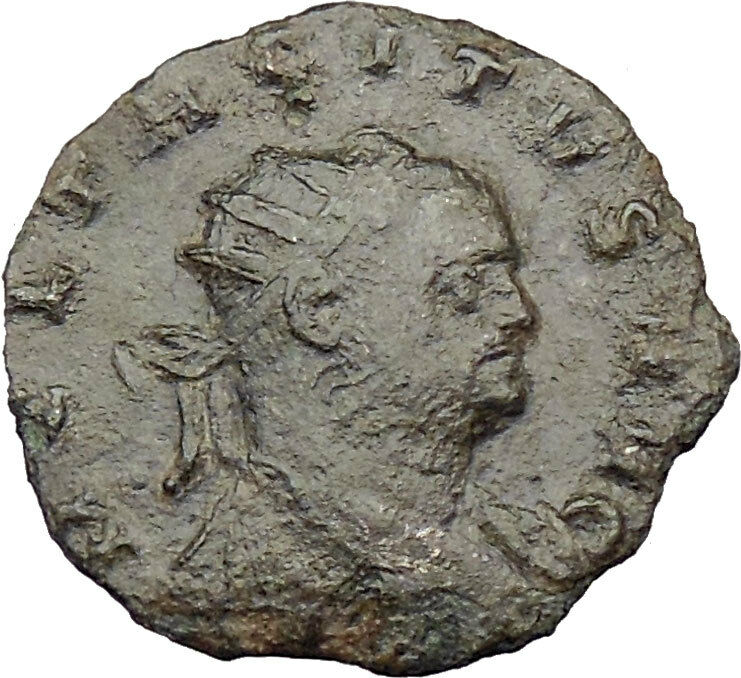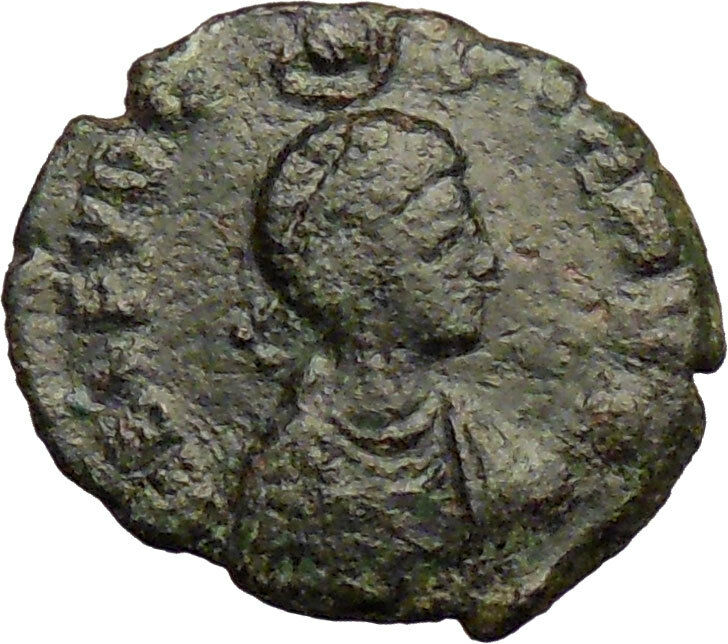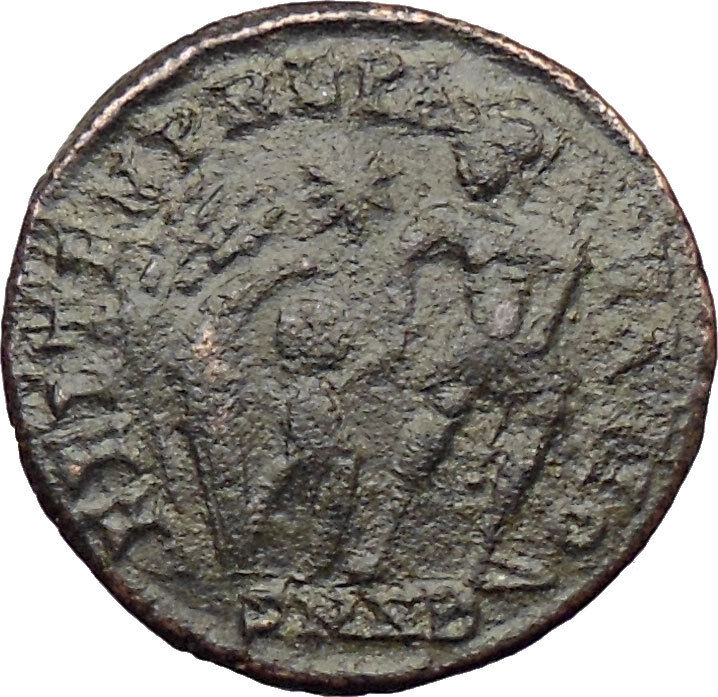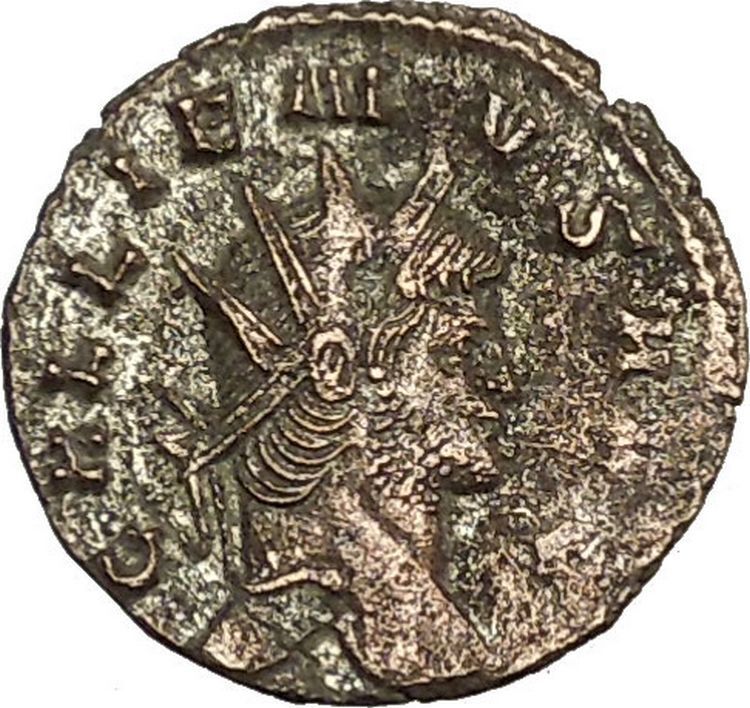|
Probus
–
Roman Emperor
: 276-282
A.D. –
Silvered
Bronze Antoninianus 23mm (3.55 grams) Serdica mint 277 A.D.
Reference: RIC 844c
IMPCMAVRPROBVSPFAVG – Radiate, draped and cuirassed bust right.
PROVIDENDEOR Exe: */KAB – Providentia standing right on left, holding a
standard
in each hand, facing Sol to right, raising hand and
holding globe.
You
are bidding on the exact item pictured, provided with a
Certificate of Authenticity
and Lifetime Guarantee of
Authenticity.
Standards

Roman military standards. The standards with
discs, or signa (first three on
left) belong to centuriae of the
legion (the image does not show the heads of
the standards – whether spear-head or
wreathed-palm). Note (second from right)
the legion’s
aquila
.
The standard on the extreme right probably
portrays the
She-wolf
(lupa)
which fed
Romulus
,
the legendary founder of Rome. (This was the
emblem of
Legio VI Ferrata
,
a legion then based in
Judaea
, a
detachment of which is known to have fought
in Dacia). Detail from Trajan’s Column, Rome

Modern reenactors parade with replicas of
various legionary standards. From left to
right: signum (spear-head type), with
four discs; signum (wreathed-palm
type), with six discs; imago of
ruling emperor; legionary aquila;
vexillum of commander (legatus)
of
Legio XXX Ulpia
Victrix
, with embroidered
name and emblem (Capricorn) of legion
Each tactical unit in the imperial army, from
centuria upwards, had its own standard. This
consisted of a pole with a variety of adornments that
was borne by dedicated standard-bearers who normally
held the rank of duplicarius. Military standards
had the practical use of communicating to unit members
where the main body of the unit was situated, so that
they would not be separated, in the same way that modern
tour-group guides use umbrellas or flags. But military
standards were also invested with a mystical quality,
representing the divine spirit (genius) of the
unit and were revered as such (soldiers frequently
prayed before their standards). The loss of a unit’s
standard to the enemy was considered a terrible stain on
the unit’s honour, which could only be fully expunged by
its recovery.
The standard of a centuria was known as a
signum, which was borne by the unit’s signifer.
It consisted of a pole topped by either an open palm of
a human hand or by a spear-head. The open palm, it has
been suggested, originated as a symbol of the
maniple
(manipulus
= “handful”), the smallest tactical unit in the
Roman army of the mid-Republic
.
The poles were adorned with two to six silver discs (the
significance of which is uncertain). In addition, the
pole would be adorned by a variety of cross-pieces
(including, at bottom, a crescent-moon symbol and a
tassel). The standard would also normally sport a
cross-bar with tassels.[194]
The standard of a Praetorian cohort or an auxiliary
cohort or ala was known as a
vexillum
or banner.
This was a square flag, normally red in colour, hanging
from a crossbar on the top of the pole. Stitched on the
flag would be the name of the unit and/or an image of a
god. An exemplar found in Egypt bears an image of the
goddess Victory on a red background. The vexillum
was borne by a vexillarius. A legionary
detachment (vexillatio) would also have its own
vexillum. Finally, a vexillum
traditionally marked the commander’s position on the
battlefield.[194]
The exception to the red colour appears to have been the
Praetorian Guard, whose vexilla, similar to their
clothing, favoured a blue background.
From the time of
Marius
(consul 107 BC),
the standard of all legions was the
aquila
(“eagle”).
The pole was surmounted by a sculpted eagle of solid
gold, or at least gold-plated silver, carrying
thunderbolts in its claws (representing
Jupiter
, the highest
Roman god. Otherwise the pole was unadorned. No exemplar
of a legionary eagle has ever been found (doubtless
because any found in later centuries were melted down
for their gold content).[194]
The eagle was borne by the aquilifer, the
legion’s most senior standard-bearer. So important were
legionary eagles as symbols of Roman military prestige
and power, that the imperial government would go to
extraordinary lengths to recover those captured by the
enemy. This would include launching full-scale invasions
of the enemy’s territory, sometimes decades after the
eagles had been lost e.g. the expedition in 28 BC by
Marcus Licinius Crassus
against
Genucla
(Isaccea, near
modern
Tulcea
, Rom., in the
Danube delta region), a fortress of the
Getae
, to recover
standards lost 33 years earlier by
Gaius Antonius
, an
earlier
proconsul
of
Macedonia
.[195]
Or the campaigns of AD 14-17 to recover the three eagles
lost by
Varus
in AD 6 in the
Teutoburg Forest
.
Under Augustus, it became the practice for legions to
carry portraits (imagines) of the ruling emperor
and his immediate family members. An imago was
usually a bronze bust carried on top of a pole like a
standard by an imaginifer.
From around the time of Hadrian (r. 117-38), some
auxiliary alae adopted the dragon-standard (draco)
commonly carried by Sarmatian cavalry squadrons. This
was a long cloth wind-sock attached to an ornate
sculpture of an open dragon’s mouth. When the bearer (draconarius)
was galloping, it would make a strong hissing-sound.
Decorations
The Roman army awarded a variety of individual
decorations (dona) for valour to its legionaries.
Hasta pura was a miniature spear; phalerae
were large medal-like bronze or silver discs worn on the
cuirass; armillae were bracelets worn on the
wrist; and
torques
were worn round
the neck, or on the cuirass. The highest awards were the
coronae (“crowns”), of which the most prestigious
was the corona civica, a crown made oak-leaves
awarded for saving the life of a fellow Roman citizen in
battle. The most valuable award was the corona
muralis, a crown made of gold awarded to the first
man to scale an enemy rampart. This was awarded rarely,
as such a man hardly ever survived.[196]
There is no evidence that auxiliary common soldiers
received individual decorations like legionaries,
although auxiliary officers did. Instead, the whole
regiment was honoured by a title reflecting the type of
award e.g. torquata (“awarded a torque”) or
armillata (“awarded bracelets”). Some regiments
would, in the course of time, accumulate a long list of
titles and decorations e.g. cohors I Brittonum Ulpia
torquata pia fidelis c.R..[193]
In
Roman mythology
,
Providentia was the
goddess
of
forethought. Providentia.
(Providence).—-With all their vices, follies, and
gross superstitions (indeed, in spite of them), the
Romans still appear to have cherished a belief in the
perpetual and direct interposition of the gods with
respect to human affairs.—-Among the various monuments
which attest this religious feeling, or at leas this
profession of religion, on the part of both princes and
people, none are more conspicuous than those to be found
on their imperial coins, for it is to be observed
that previous to the substitution of the monarchical for
the republican form of government, that allegorical
divinity whose name is derived from providere (to
foresee) is not seen either on metal or on marble.In
ancient Roman religion
,
Providentia is a divine personification of the
ability to foresee and make provision. She was among the
embodiments of
virtues
that were part
of the
Imperial cult of ancient Rome
.Providentia
thus figures in
art
, cult, and
literature
, but has
little or no
mythology
as such.
Providentia was an important moral and
philosophical abstraction in Roman discourse.
Cicero
says it is one
of the three main components of prudentia, “the
knowledge of things that are good or bad or neither,”
along with memoria, “memory,” and
intellegentia, “understanding.” The Latin word is
the origin of the Christian concept of
divine providence
.
Imperial cult
Upon the death of
Augustus
, the emperor
Tiberius
established an
altar
to Providentia
Augusta in recognition of “the godhead manifested in his
father’s provisions for the
Roman state
.” The cult
title
Augusta
was attached
also to such goddesses as
Pax
,
Justitia
, and
Concordia
during the
Imperial era
.
Traditional epithets invoked a deity within a specific
functional sphere by declaring their power. The title
Augusta thus fixed the divinity’s force within the
sphere of the emperor as Augustus.
In 28 AD, after Tiberius arrested and executed
Sejanus
for conspiracy,
the Cult of Virtues played a role in the propaganda that
presented the restoration of Imperial order as a return
to constitutional government. Sacrifices were offered to
Providentia along with Salus (“Security”),
Libertas
(“Liberty”),
and the
Genius
. Providentia at
this time also received a permanent full-time priest
(sacerdos)
devoted to her. In the wake of the
Pisonian conspiracy
against
Nero
, religious
observances in 59 AD to repair the state included
sacrifices by the
Arval Brethren
to
various deities, among them Providentia.
Providentia appeared on
Roman coins
issued
under
Vespasian
,
Trajan
,
Hadrian
,
Antoninus Pius
,
Septimius Severus
,
Commodus
and
Diocletian
. A coin
issued by
Titus
depicted his
deified father Vespasian handing a globe to his son as
his successor, with the legend Providentia Augusta.
Coins issued by
Nerva
depicted the
Genius of the
Senate
handing the
globe to the new emperor, with the legend Providentia
Senatus, “the Providence of the Senate.”
Providentia in numismatics

The figure of Providentia from a sculpture
group in Vienna, as depicted on an Austrian
100-euro gold coin
Providentia has been the main motif for many
collector coins and medals, the most recent one is the
famous
100 euro Sculpture Gold coin
issued on November 13, 2002. The reverse features the
Providentia Fountain (“Provendentia Brunnen”) in central
Vienna, work of one of the greatest baroque sculptor
Georg Rafael Donner
. In
the centre of the coin, the allegorical figure of
Providentia with a medallion of the Roman god,
Janus
, who had two
faces, is displayed. Surrounding the fountain there are
other symbolic figures representing tributary rivers of
the
Danube
. Providentia is
enthroned high above the figure of an old man
representing the
Enns River
.
Marcus
Aurelius Probus
(c. August 19,
232–September/October, 282) was a
Roman Emperor
(276–282).

A native of
Sirmium
(now
Sremska Mitrovica
,
Serbia
), in
Pannonia
, at an early age he entered the army, where
he distinguished himself under the Emperors
Valerian
,
Aurelian
and
Tacitus
. He was appointed governor of the East by
Tacitus, at whose death he was immediately proclaimed
his successor by the soldiers (276).
Florianus
, who had claimed to succeed his
half-brother Tacitus, was put to death by his own troops
after an indecisive campaign. Probus moved to the West,
defeated the Goths acquiring the title of Gothicus
(280), and saw his position ratified by the
Senate
.
The reign of Probus was mainly spent
in successful wars by which he re-established the
security of all the frontiers. The most important of
these operations were directed to clearing
Gaul
of German invaders (Franks,
Longiones
,
Alamanni
and
Burgundians
), allowing Probus to adopt the titles of
Gothicus Maximus and Germanicus Maximus.
One of his principles was never to allow the soldiers to
be idle, and to employ them in time of peace on useful
works, such as the planting of vineyards in Gaul,
Pannonia and other districts, in order to restart the
economy in these devastated lands.
In 279–280, Probus was, according to
Zosimus
, in
Raetia
,
Illyricum
and
Lycia
, where he fought the
Vandals
. In the same years, Probus’ generals
defeated the
Blemmyes
in
Egypt
; Probus ordered the reconstruction of bridges
and canals along the Nile, where the production of grain
for the Empire was centered.
In 280–281, Probus had also put down
three usurpers,
Julius Saturninus
,
Proculus
and
Bonosus
. The extent of these revolts is not clear,
but there are clues that they were not just local
problems.
In 281, the emperor was in Rome, where he celebrated his
triumph
.
Probus was eager to start his eastern
campaign, delayed by the revolts in the west. He left
Rome in 282, moving first towards Sirmium, his birth
city, when the news that
Marcus Aurelius Carus
, commander of the
Praetorian Guard
, had been proclaimed emperor
reached him. Probus sent some troops against the new
usurper, but when those troops changed sides and
supported Carus, Probus’s soldiers then assassinated him
(September/October 282).
|












